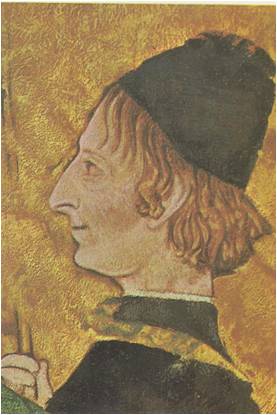One day in the fifteenth century, the Turkish potentate of Babylonia decided to send gifts to the greatest ruler in Italy. He consulted his counselors and men who had traveled widely in Europe, asking them who best deserved this honour. They agreed that one Italian court outshone the rest and that his court must surely be the home of Italy’s mightiest sovereign. They did not name Milan, the home of the proud Sforza, nor Florence, the city of the clever Medici. The most magnificent court in Italy, they said, was at Ferrara, the capital of the dukes whose family name was d’Este and to Ferrara the Turkish potentate’s ambassadors carried the presents. Ferrara was small, a mere toy state in comparison to Milan or Florence. Actually, it was not an independent state at all. Like several of its neighbours in central Italy, Ferrara had for centuries belonged to the Church. Its duke paid an annual tribute to the pope for the privilege of governing his family dukedom himself. Even so, the Turkish potentate’s advisers had made no mistake. No court in Italy could match the splendor of the court commanded by the dukes of little Ferrara. During the Renaissance, there were many such small cities that won fame. It all depended on their rulers — the ambitious dukes or counts or sometimes, commoners who had gained riches and power. With their money, they, too, hired fine artists, sculptors and architects; they, too, collected manuscripts and things of beauty. So the small cities were as much part of the new age as Florence or Milan. In that new age, Ferrara was a place of old fashioned grandeur. Its dukes, the d’Estes, had come to power in the last days of chivalry. In 200 years, the d’Estes had turned Ferrara into a …
Read More »Florence, First City of the Renaissance 1200-1480
March 25, 1436, was the Feast of the Annunciation and the city of Florence was decked out for a celebration. Banners flew everywhere, ribbons and garlands of flowers decorated the houses and draperies of cloth-of-gold were looped across the shop-fronts. The city bustled with excitement, for on this Annunciation Day the pope was to dedicate the Duomo, the wonderful new Cathedral of Santa Maria del Fiore, then the largest church in the world. At dawn, the people began to fill the streets. They crowded around the high wooden walk that led to the cathedral from the monastery where the pope was staying. At mid-morning, when a blare of trumpets signaled the start of the ceremonies, a great procession filed along the walk. The pope, robed in white and crowned with a tiara, was attended by seven cardinals, clothed in scarlet and 37 bishops and archbishops, all in purple. There were the priors, the governors of Florence and the representatives of the people of sixteen districts of the city. Each representative carried a standard marked with the emblem of his district, such as the lion, the unicorn, or the viper. Marching in a solemn line came the leaders of the seven great guilds — the wool merchants, the Silk weavers, the bankers, the notaries, the druggists (who also dealt in spices and jewels), the furriers and the calimala, the ancient and honoured guild of cloth merchants. Behind them came the officers of fourteen “Guilds of Lesser Arts” shoemakers, bakers, innkeepers, grocers, carpenters and the like. As the procession entered the cathedral, all the church bells in Florence rang out. Their deep voices called across the city, resounded in the fields beyond and echoed in the hills of Tuscany. Triumphantly they proclaimed the greatness of the new Duomo that the Florentines said …
Read More »

